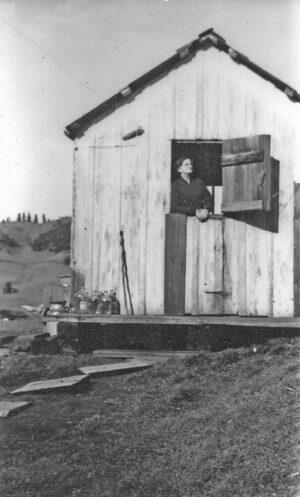An event happened during World War II in Oregon that could have easily happened on the Mendocino Coast if Mother Nature’s winds had blown farther south.

Unidentified volunteer searching the sky for enemy aircraft and exploding balloons at the Comptche Aircraft Warning Station, c. 1945. According to the Mendocino Beacon, “The service is all voluntary but the best information we have is that there must always be someone on watch as Mendocino County is thought to be more likely than most others chosen as a point of crossing by enemy planes intent on invading the Sacramento Valley.” (Kelley House Museum Archives)
On the bright spring day of May 5, 1945, a minister and his wife took a youth group on a hike in the Oregon woods near Bly, east of Klamath Falls. Christian Alliance Church leader Archie Mitchell dropped his wife and five youngsters off on a trail, then drove his car down the road to pick them up at the other end of the trail.
As they hiked, the children spotted something hanging from a tree and pulled on it. This set off a violent explosion that immediately killed Mrs. Mitchell and the children. Two foresters heard the explosion and came quickly. They found the minister surveying the terrible scene in horror.
What killed them? While there was tight censorship of military news at this time, it turned out to be a paper incendiary balloon, launched from Japan into high air currents to crash into timberlands and start wildfires after floating over the Pacific Ocean. The Japanese military hoped this would cause a disruption in lumber supplies needed for war production projects.
This woman and those children became the only fatalities from enemy action in the continental US during World War II. If the wind had blown farther south, the balloon could easily have landed on the northwest California coast.
It is estimated 225 incendiary balloons fell from Alaska to Mexico, and one made it as far as Michigan. One crossed the Pacific Ocean in a day and a half. The balloons carried 150 pounds of explosives.
This tragedy happened towards the end of the war, and any publicity would let the Japanese government know the balloons were reaching the mainland. Even though authorities and civilians knew about these balloons, all news regarding them was censored.
Woodsmen, forest patrols, and lookouts stationed in towers erected to watch for enemy planes and submarines were all alerted to watch for balloons, too. The Mendocino Coast had several of these lookouts, including one on Matheson Peak on the Comptche-Ukiah Road, another on King Summit on Flynn Creek Road near Comptche, and one within the town of Mendocino near the high school.
Also kept under censorship was news of the June 1942 attack by a Japanese submarine off Fort Stevens near the mouth of the Columbia River in Oregon, where nine shells were shot into sand dunes. Thankfully, no one was injured.
Twice in September 1942 small planes launched from Japanese subs dropped incendiary bombs into the woods in broad daylight near Brookings and Cape Blanco, but the bombs failed to ignite.
The era of World War II was actually good for the lumber industry in the Pacific Northwest and Northern California. Wood was needed to build hangers, warehouses, factories, and housing for war workers. Docks, wharves, dry docks, bridges, and trenches all needed lumber. Ships and airplanes had wooden components. Woodsman were in short supply as they had all been drafted into the military, but the “Lipstick Brigade” (women) stepped in to help in lumber mill jobs.
The Mendocino Coast was lucky to never have to deal with the Japanese floating incendiary balloons. In Oregon, a patriotic shrine was erected the 1950s by Weyerhaeuser Timber Company at the place of the explosion, and the State designated it the “Mitchell Recreation Area” with a historical marker inscribed with the names of those lost.